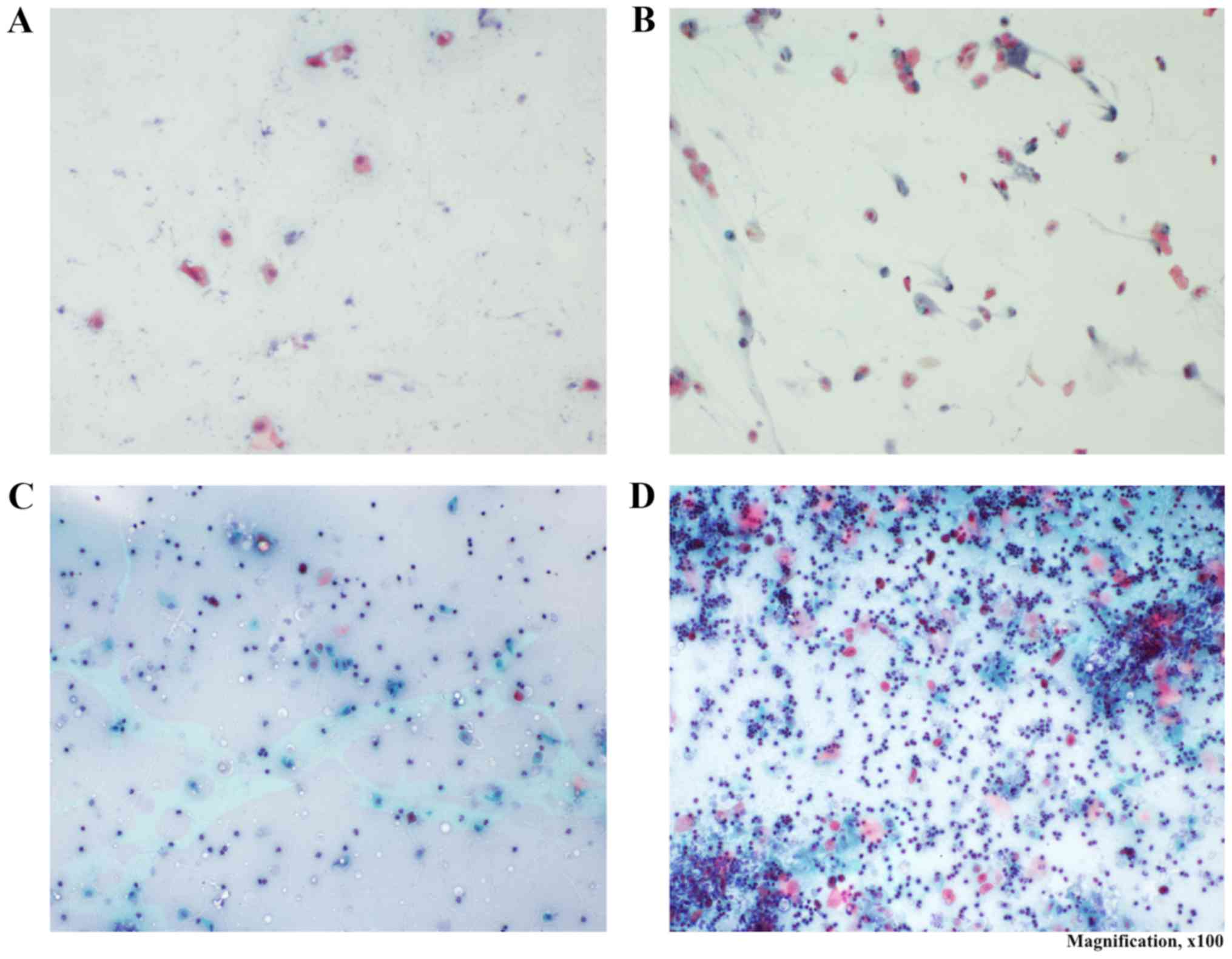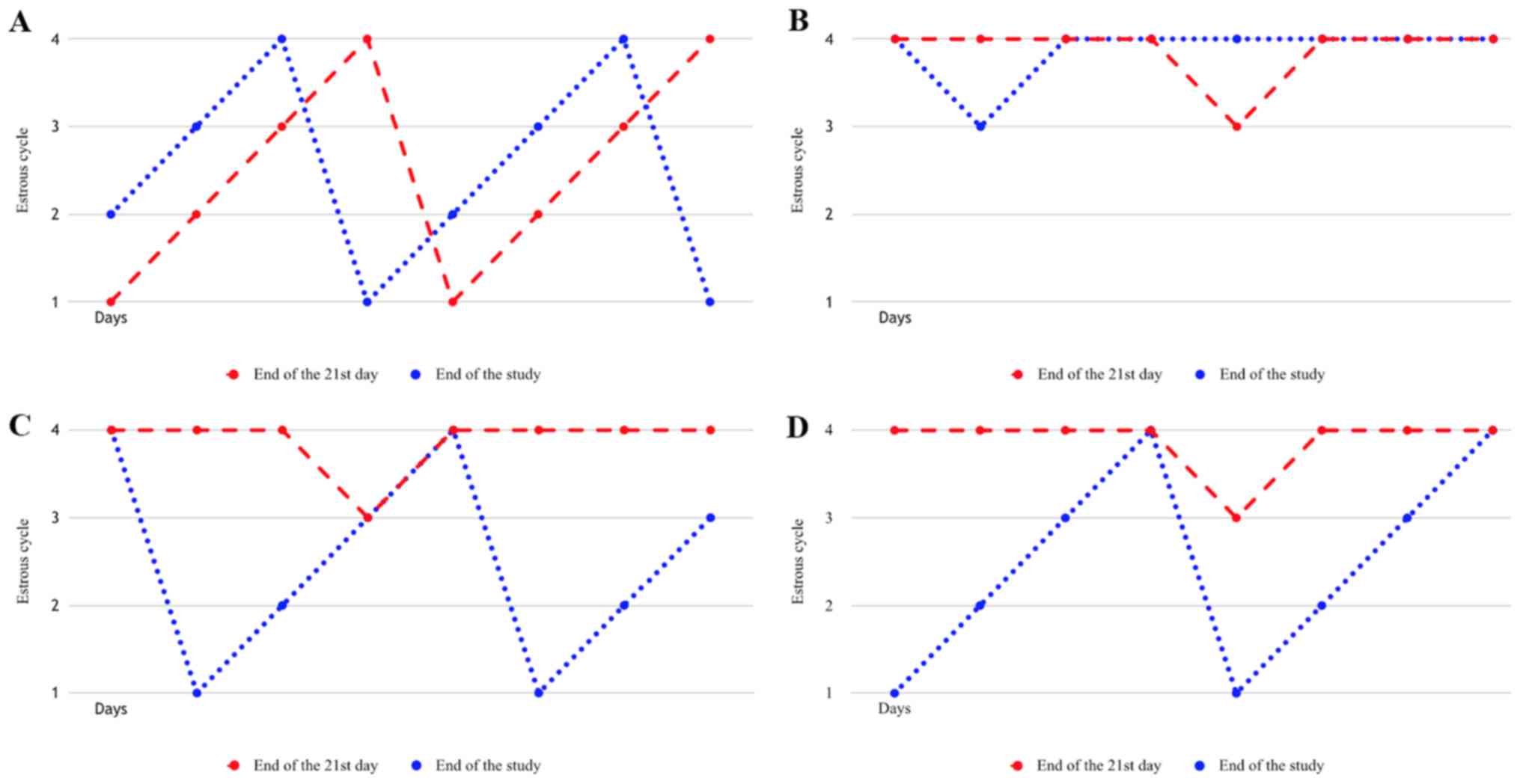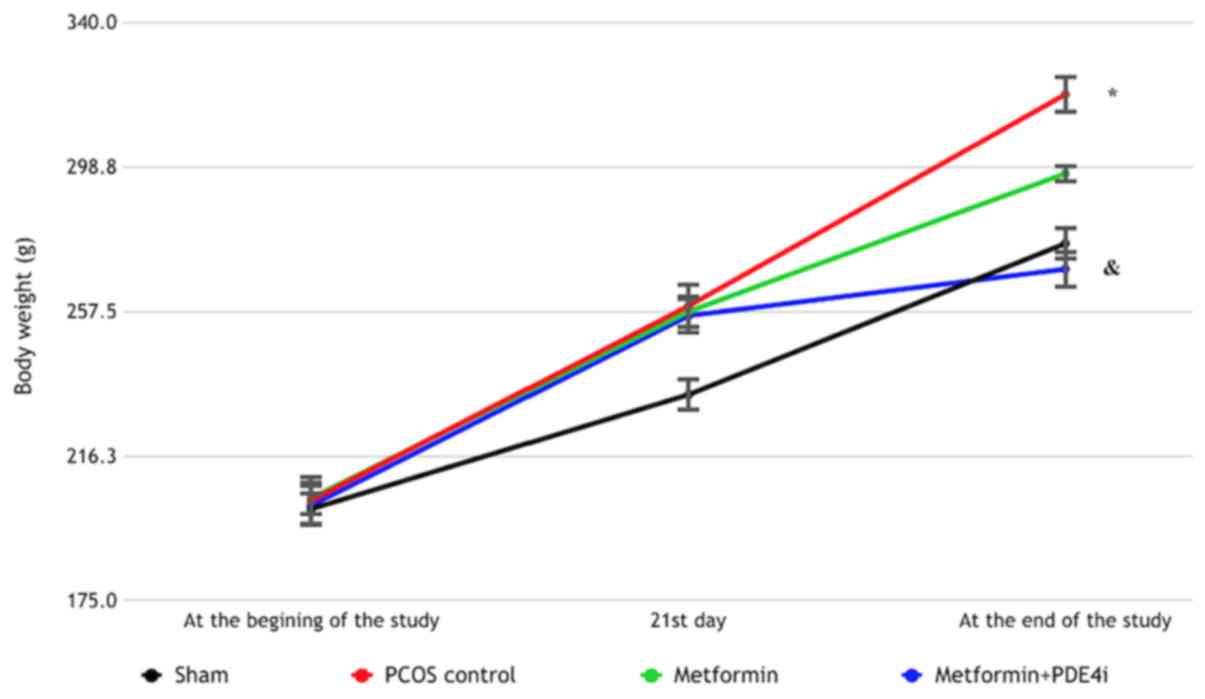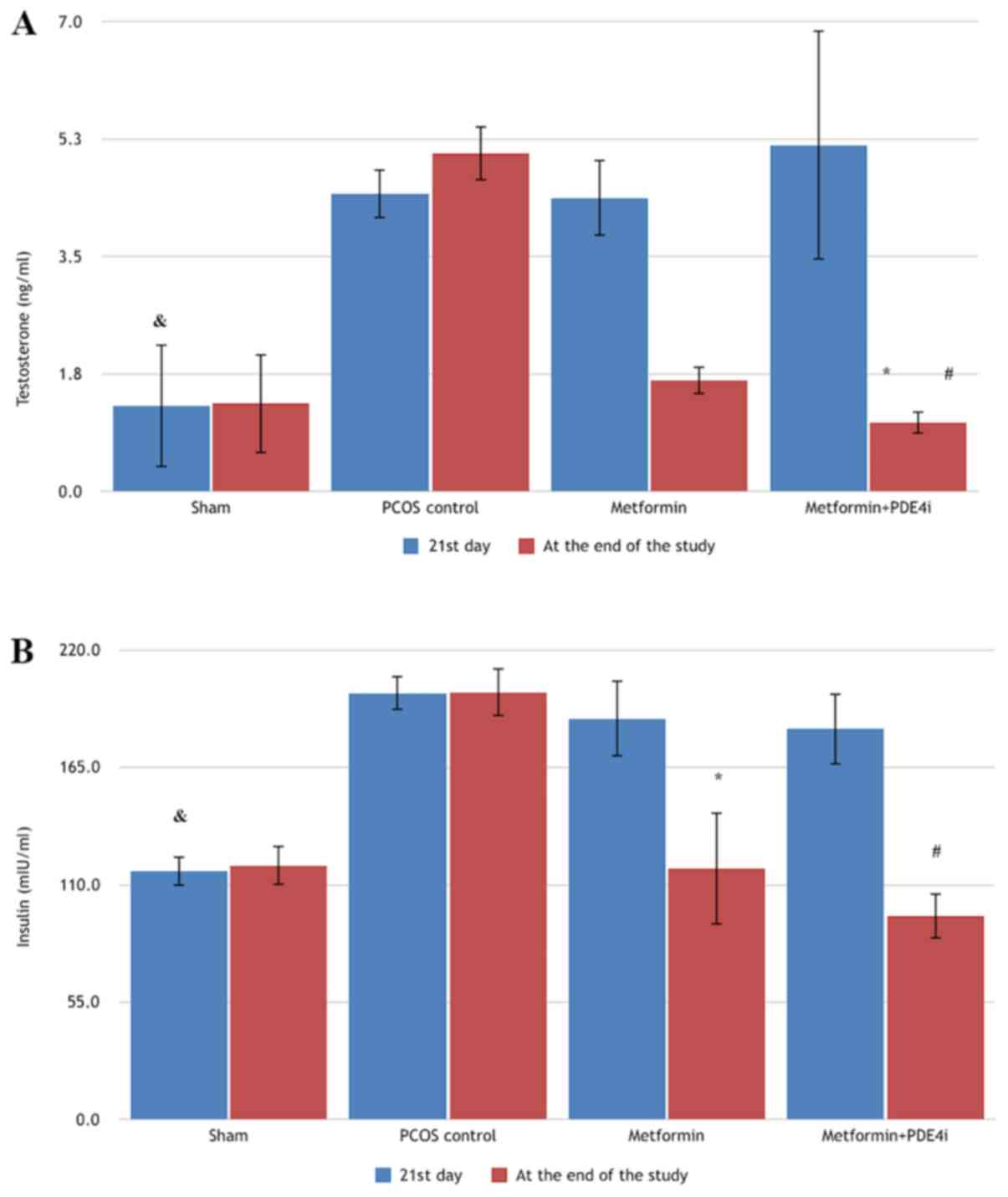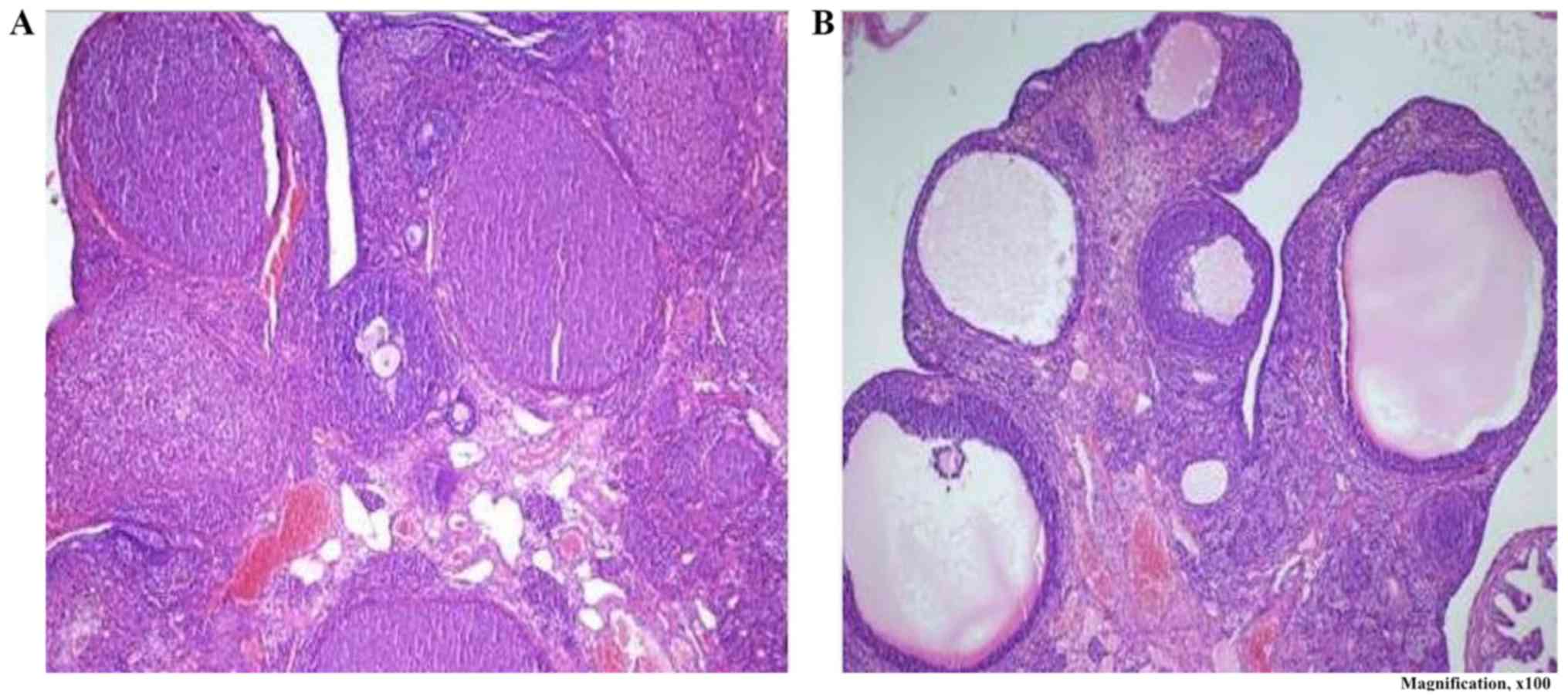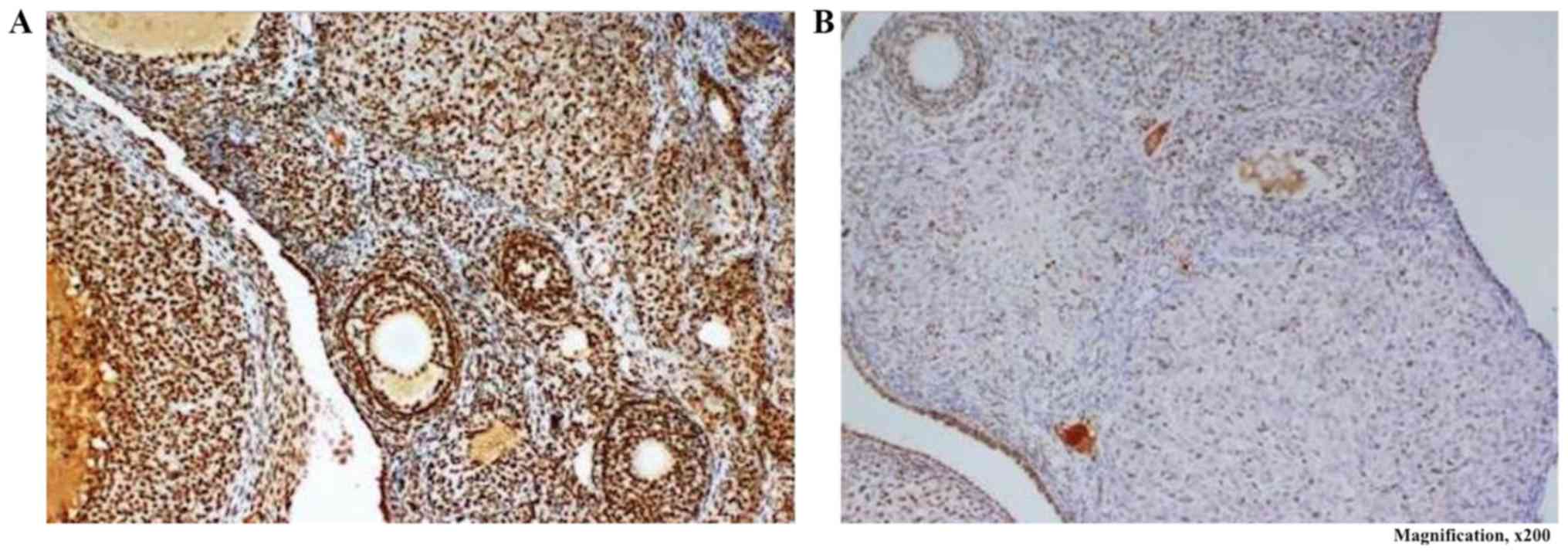Introduction
Polycystic ovary syndrome (PCOS) is a metabolic and
hormonal disorder that was first described in 1935 by Stein and
Leventhal (1). PCOS is a
multifactorial, heterogenous disorder, most commonly affecting
women of reproductive age. The worldwide prevalence of this
heterogeneous disorder is 2.2–26.7% (2). PCOS is characterized by hormonal
irregularity, including an increased luteinizing hormone (LH)
level, a decrease in the follicle-stimulating hormone (FSH) level,
hyperandrogenemia and hyperinsulinemia, anovulation and, as a
result, menstrual disorders such as oligo/amenorrhea and polycystic
ovaries (3,4).
PCOS is a complex syndrome and there are numerous
theories regarding its pathophysiology, including impaired
androgen, cortisol, lipid and insulin metabolism, as well as
chronic subclinical inflammatory processes (5). Chronic ovarian inflammation may cause
endocrinological, structural and metabolic changes, ultimately
resulting in the development of PCOS (5,6). Animal
studies demonstrated that proinflammatory cytokines increase
ovarian steroidogenic enzyme levels, leading to an increase in
androgen production, whereas anti-inflammatory agents, such as
statins and resveratrol, decrease androgen production (7,8). These
findings support the hypothesis that PCOS is a proinflammatory
disorder, and that chronic subclinical inflammatory processes
directly stimulate the development of PCOS-associated metabolic
abnormalities and ovulatory dysfunction.
Cyclic nucleotide phosphodiesterases (PDEs) are
important for the metabolism of cyclic adenosine monophosphate
(cAMP) and cyclic guanosine monophosphate (cGMP), both of which
have potent anti-inflammatory properties. The PDE superfamily
consists of 11 enzyme subtypes (PDE1-11), some of which hydrolyze
cAMP (PDE4, PDE7 and PDE8), whereas others hydrolyze cGMP (PDE5,
PDE6 and PDE9) (9). PDEs are found
in all cells and, in particular, PDE4 and PDE3 are highly expressed
in human ovaries and inflammatory cells (10). Inhibition of these enzymes is used to
treat chronic inflammatory diseases, such as chronic obstructive
pulmonary disease (11). Moreover,
the PDE enzymes regulate proinflammatory mediators and the steroid
hormone biosynthesis pathway in the ovaries, and may thus play a
key role in the pathophysiology of PCOS (12–14).
Metformin has a modest effect in the management of
PCOS and PCOS-related obesity (15).
Therefore, new therapeutic agents in combination with metformin are
needed. PDE-4 inhibitors (PDE4i) which are used for chronic
obstructive pulmonary disease have important roles in ovarian
steroidogenesis and glucose metabolism (13) and therefore may have a value in the
management of PCOS and PCOS-related obesity. However, there is
paucity of data in the literature regarding the potential
synergistic role of PDE4i in the management of PCOS and
PCOS-related obesity (14,16) and there are no data about additive
effects of PDE4i on ovarian morphology and phosphorylated cyclic
AMP response element binding protein (pCREB) expression (with
immunohistochemical staining). Therefore, the aim of the present
study was to determine the effect of a PDE4i combined with
metformin on ovarian morphology, weight and hormonal changes in a
rat model of PCOS.
Materials and methods
Animals
The present study included 40 female Sprague-Dawley
rats (weight, 193–215 g) supplied by the Başkent University
Experimental Animal Center (Ankara, Turkey). All the rats were
housed in standard cages at 23°C, 50–60% humidity and a 12-h light
and dark cycle, with free access to food and water. The study
protocol was approved by the Başkent University Animal Care and Use
Committee (project no. DA15/45), in accordance with Turkish
legislation for animal experimentation.
Study groups
The rats were randomly divided into 4 groups
(n=10/group) as follows: Sham, PCOS control, metformin and
metformin + PDE4i.
Sham group
Rats in the sham group were injected with 0.2 ml
sesame oil for 21 days (days 1–21), after which time they received
only distilled water via orogastric gavage for the next 28
days.
PCOS control group
Rats in the PCOS control group received daily
subcutaneous (SC) injections of dehydroepiandrosterone (DHEA;
Biosteron 25 mg; Lekam Pharmaceutical, Zakroczym, Poland) at 60
mg/kg/day dissolved in 0.1 m sesame oil for 21 days (days 1–21) to
induce PCOS as described by Anderson et al (17). Hyperandrogenemia and irregular
cycle/anovulation based on vaginal smear examination were
considered as successful PCOS induction (18,19).
After induction of PCOS, the rats were given only distilled water
via orogastric gavage for the next 28 days; they did not receive
any drugs.
Metformin group
After induction of PCOS, the rats were administered
metformin (Glucophage 500 mg; Merck Pharmaceuticals, Semoy, France)
at 300 mg/kg/day via orogastric gavage for the next 28 days. The
metformin dose used in this study was equivalent to that used in
the treatment of PCOS patients (20,21).
Metformin + PDE4i group
After induction of PCOS, the rats were administered
metformin (Glucophage 500 mg; Merck Pharmaceuticals) at 300
mg/kg/day plus PDE4i (Daxas 500 mcg; Takeda Pharmaceuticals, Osaka,
Japan) at 0.5 mg/kg/day via orogastric gavage for the next 28 days.
The PDE4i dose used in this study was equivalent to that used in
the treatment of PCOS patients (14,21).
Sample collection and data recording
Body weight
Body weight was measured every 7 days, from day 1 to
day 49.
Vaginal smears
Vaginal smears were performed and examined daily
under a light microscope for determination of the stage of each
rat's estrous cycle, based on the dominant cell types as follows:
Pro-estrus smear, round and nucleated epithelial cell types; estrus
smear, cornified squamous epithelial cells; metestrus smear,
cornified squamous epithelial cells and a predominance of
leukocytes; and diestrus smear, nucleated epithelial cells and a
predominance of leukocytes. The ovulation of female rats occurs
from the onset of pro-estrus phase to the end of estrus phase, and
the mean cycle length of female rats is 4 days. The phase sequence
pro-estrus, estrus, metestrus and diestrus was considered as
regular. Irregular cycles were characterized by remaining in the
same phase for 4–5 days, or if the phases did not follow the
sequence mentioned above. Due to these properties, rats are
considered as an optimal model for investigating changes that occur
throughout the reproductive cycle (22) (Fig.
1).
Serum and ovaries
At the end of 21st day, blood samples were collected
from the heart of all rats and centrifuged for 15 min at 2,500 rpm.
The upper layer of serum was transferred into an Eppendorf tube and
stored at −80°C. At the end of the study, all rats were
anesthetized with 40 mg/kg ketamine hydrochloride (Ketosal;
Interhas Co. Ltd., Ankara, Turkey) and 5 mg/kg of xylazine
hydrochloride (Xylazin Bio, Interhas Co. Ltd.) via intraperitoneal
injection, and euthanized by cervical dislocation after heart blood
sampling via cardiac puncture. Samples of blood were taken from the
ventricle of heart by accessed either via the left side of the
chest, through the diaphragm, from the top of the sternum. Death of
rats were confirmed by heart beat (assessed for five minutes or
more), pupillary response to light (dilated and unresponsive to
light) and respiratory pattern (lack of spontaneous breathing). In
all rats, 5–7 ml of blood was available for collection and was
centrifuged for 15 min at 2,500 rpm. The upper serum layer was
transferred into an Eppendorf tube and stored at −80°C. Next, 1
ovary from each rat was removed and fixed in 4% paraformaldehyde,
whereas the other ovary was removed, frozen in liquid nitrogen, and
then stored at −80°C for further analysis.
Testosterone and insulin
measurement
The serum testosterone (ng/ml) and insulin levels
(uIU/ml) were determined by ELISA kits (Cusabio Biotech. Co., Ltd.,
Wuhan, China) and only the testosterone and insulin levels were
measured, as some studies have reported that DHEA-induced PCOS in
rats is associated with excess androgen, LH hypersecretion, an
irregular estrous cycle, and an elevated insulin level, whereas
others reported no change in LH and FSH levels (8,23–25).
Ovarian morphology and
immunohistochemistry
The ovaries from the rats in the all groups were
removed, processed and embedded in paraffin blocks. Hematoxylin and
eosin staining was performed and slides were assayed.
Immunohistochemical staining was performed to quantify
phosphorylated cyclic AMP response element-binding protein (pCREB)
expression in all groups. The intensity of pCREB expression was
graded as follows: Negative, 0; weak, 1; moderate, 2; and strong,
3. The percentage of positively stained cells was also recorded.
The staining pattern was evaluated as follows: High expression,
≥50% of cells exhibiting moderate-strong intensity; and low
expression, <50% of cells exhibiting moderate-strong intensity
(26).
Statistical analysis
Data were analyzed using MS-Excel 2010 for Windows
and IBM SPSS Statistics for Windows v.22.0 (IBM Corp., Armonk, NY,
USA). The normality of the distribution of continuous variables
(weight, testosterone and insulin) was graphically and
statistically evaluated using the Shapiro-Wilk test; none of the
variables were normally distributed. Median [IQR (interquartile
range)] values were used to represent descriptive statistics.
Kruskal-Wallis non-parametric variance analysis (χ2) was used to
compare median body weight, testosterone and insulin values among
groups. In order to find different groups, Bonferroni corrected
Mann-Whitney test was used in post-hoc pairwise comparisons. The
Wilcoxon's signed rank test was used to compare values at baseline
(day 1) and at the end of the study. The level of statistical
significance was set at P<0.05.
Results
Animals
The study was initiated with 40 rats randomly
distributed into 4 groups (n=10/group); however, 1 rat in the sham
group, 1 rat in the PCOS control group, and 1 rat in the metformin
group died before day 21, and 1 rat in the metformin group was
excluded from the study due to failure to induce PCOS. The study
was completed with 36 rats: 9 (25.0%) in the sham group, 9 (25%) in
the PCOS control group, 8 (22.2%) in the metformin group, and 10
(27.8%) in the metformin + PDE4i group.
Body weight at baseline
At baseline (day 1) there was no significant
difference in the median body weight among the groups
(χ2=0.615, P=0.893). Body weight was equally distributed
in the study groups (Table I).
 | Table I.Rat body weight (grams). |
Table I.
Rat body weight (grams).
|
| Beginning of the
study | 21th day | At the end of the
study |
|---|
|
|
|
|
|
|---|
| Factor | Median (IQR) | Median (IQR) | Differences from
shama | Differences from
the beginning of the studyb | Median (IQR) | Differences from
the beginning of the studyb | Differences from
21th dayb |
|---|
| Groups |
|
|
|
|
|
|
|
| Sham
(n=9) | 201.0 (4.5) | 235.0 (8.0) |
| Z=2.677;
P=0.007 | 277.0 (9.0) | Z=2.692;
P=0.007 | Z=2.680;
P=0.007 |
| PCOS
control (n=9) | 202.0 (13.3) | 260.0 (13.0) | Z=3.936;
P<0.001 | Z=2.684;
P=0.007 | 320.0 (6.0) | Z=2.675;
P=0.007 | Z=2.670;
P=0.008 |
|
Merformin (n=8) | 202.0 (9.5) | 256.0 (10.0) | Z=3.162;
P=0.009 | Z=2.668;
P=0.008 | 296.5 (4.5) | Z=2.521;
P=0.012 | Z=2.524;
P=0.012 |
|
Metformin + PDE 4i (n=10) | 202.0 (10.0) | 255.5 (9.8) | Z=3.338;
P=0.005 | Z=2.805;
P=0.005 | 269.5 (10.3) | Z=2.809;
P=0.005 | Z=2.818;
P=0.005 |
| Comparisons of the
groupsc |
χ2=0.615; P=0.893 |
χ2=18.672; P<0.001 |
|
|
χ2=30.581; P<0.001 |
|
|
Estrous cycle and induction of
PCOS
PCOS induction was determined based on assessment of
8-day smear results from day 14 to day 21 and androgen levels;
hyperandrogenemia and irregular cycle were considered as successful
PCOS induction (18,19). All 9 rats in the sham group had a
normal cycle, whereas irregular cycles were observed in all the
rats in the PCOS control (n=9) and metformin + PDE4i (n=10) groups.
An irregular estrous cycle was observed in 8 of the rats in the
metformin group, whereas 1 rat had a regular cycle and was excluded
from the study due to failure to induce PCOS. The study continued
as designed after confirmation of PCOS induction (Fig. 2).
Body weight after induction of PCOS
(day 21)
The median body weight on day 21 differed
significantly among groups (χ2=18.672, P<0.001).
Based on post hoc binary comparison performed to identify
between-group differences, all treatment groups had a higher median
body weight compared with the sham group on day 21 (P<0.01),
whereas the median body weight did not differ significantly between
the 3 study groups (P>0.05) (Table
I and Fig. 3).
Testosterone and insulin levels
following induction of PCOS
Testosterone and insulin levels were measured in all
groups on day 21. The median testosterone on day 21 differed
significantly among groups (χ2=19.533, P<0.001). Post
hoc test results revealed that the median testosterone level in the
3 study groups was significantly higher compared with that in the
sham group on day 21 (P<0.05), whereas there was no significant
difference among the 3 study groups (P>0.05) (Table II; Fig.
4A). The median insulin level also differed significantly among
groups (χ2=21.864, P<0.001). The median insulin level
was significantly lower in the sham group compared with the 3 study
groups on day 21 (P<0.05), but did not differ significantly
among the 3 study groups (P>0.05) (Table III; Fig.
4B).
 | Table II.Testosterone levels. |
Table II.
Testosterone levels.
|
| 21th day | At the end of the
study |
|---|
|
|
|
|
|---|
| Factor | Median (IQR) | Differences from
shama | Median (IQR) | Differences from
21th dayb |
|---|
| Groups |
|
|
|
|
| Sham
(n=9) | 1.07 (1.04) |
| 1.22 (0.66) | Z=0.415;
P=0.678 |
| PCOS
control (n=9) | 4.40 (0.61) | Z=3.474;
P=0.003 | 4.88 (0.65) | Z=2.547;
P=0.011 |
|
Merformin (n=8) | 4.35 (0.95) | Z=2.821;
P=0.015 | 1.67 (0.36) | Z=2.521;
P=0.012 |
|
Metformin + PDE 4 inhibitor
(n=10) | 4.69 (1.85) | Z=4.109;
P<0.001 | 1.05 (0.22) | Z=2.803;
P=0.005 |
| Comparisons of the
groupsc |
χ2=19.533; P<0.001 |
|
χ2=27.057; P<0.001 |
|
 | Table III.Insulin levels. |
Table III.
Insulin levels.
|
| 21th day | At the end of the
study |
|---|
|
|
|
|
|---|
| Study groups | Median (IQR) | Differences from
shama | Median (IQR) | Differences from
21th dayb |
|---|
| Groups |
|
|
|
|
| Sham
(n=9) | 117.32 (11.29) |
| 119.92 (14.15) | Z=2.310;
P=0.021 |
| PCOS
control (n=9) | 198.78 (15.17) | Z=4.573;
P<0.001 | 194.52 (18.91) | Z=0.059;
P=0.953 |
|
Merformin (n=8) | 184.57 (28.14) | Z=2.918;
P=0.012 | 106.63 (53.97) | Z=2.521;
P=0.012 |
|
Metformin + PDE 4 inhibitor
(n=10) | 177.83 (28.69) | Z=3.085;
P=0.006 | 97.12 (17.52) | Z=2.803;
P=0.005 |
| Comparisons of the
groupsc |
χ2=21.864; P<0.001 |
|
χ2=25.347; P<0.001 |
|
Body weight at the end of the
study
At the end of the study, median body weight differed
significantly among groups (χ2=30.581, P<0.001). Post
hoc binary comparison performed to identify between-group
differences revealed that there was a significant difference
between the metformin + PDE4i and metformin alone groups (Z=3.284,
P=0.006), between the metformin + PDE4i and PCOS control groups
(Z=5.147, P<0.001), and between the sham and PCOS control groups
(Z=3.783, P=0.001). At the end of the study, median body weight was
the highest in the PCOS control group, followed by the metformin,
sham and metformin + PDE4i groups (Table
I; Fig. 3).
Testosterone level at the end of the
study
At the end of the study, the median testosterone
level differed significantly among groups (χ2=27.057,
P<0.001). Post hoc binary comparison performed to identify
between-group differences revealed that there was a significant
difference between the metformin + PDE4i and metformin alone groups
(Z=2.697, P=0.042), between the metformin + PDE4i and PCOS control
groups (Z=4.876, P<0.001), and between the sham and PCOS control
groups (Z=3.782, P=0.001). At the end of the study, the
testosterone level was the highest in the PCOS control group,
followed by the metformin, sham, and metformin + PDE4i groups
(Table II; Fig. 4A). As compared to day 21, the
testosterone level had changed significantly in the 3 study groups
at the end of the study (P<0.05), but not in the sham group
(Z=0.415, P=0.678). The testosterone level was increased in 8 of
the 9 rats in the PCOS control group at the end of the study, as
compared to day 21, whereas the testosterone level was lower at the
end of the study compared with that on day 21 in all the rats in
the metformin and metformin + PDE4i groups.
Insulin level at the end of the
study
At the end of the study, the median insulin level
differed significantly among groups (χ2=25.347,
P<0.001). Based on post hoc binary comparison performed to
identify between-group differences, there were significant
differences between the metformin + PDE4i and PCOS control groups
(Z=4.958, P<0.001), and between the metformin and PCOS control
groups (Z=3.199, P=0.008). At the end of the study, the median
insulin level was the highest in the PCOS control group, followed
by the sham, metformin, and metformin + PDE4i groups. As compared
to day 21, at the end of the study the change in the median insulin
level was not significant in the PCOS control group (Z=0.059,
P=0.953), whereas the change was significant in all other groups
(P<0.05) (Table III; Fig. 4B). The insulin level was increased in
7 of the 9 rats in the sham group at the end of the study, as
compared to day 21, whereas the insulin level was lower at the end
of the study in all rats in the metformin and metformin + PDE4i
groups compared with day 21.
Estrous cycle at the end of the
study
Based on vaginal smear results in all rats on the
last 8 days of the study, all 9 rats in the sham group had a normal
cycle at the end of the study. The cycle in all the rats in the
metformin (n=8) and metformin + PDE4i (n=10) groups was restored to
normal at the end of the study, whereas an irregular cycle
persisted in all the rats in the PCOS control group (n=9).
Ovarian morphology and
immunohistochemistry at the end of the study
Normal ovarian morphology was observed in the
ovarian sections of the sham, metformin and metformin + PDE4
groups, whereas numerous cystic follicles were identified in the
ovarian sections of the PCOS control group (Fig. 5).
Low expression staining pattern was observed in all
the samples obtained from the rats in the sham and PCOS control
groups, whereas high expression staining pattern was observed in 1
(12.5%) rat in the metformin group and four (40.0%) rats in the
merformin + PDE4i group (Fig.
6).
Discussion
The present study yielded two important findings.
First, the combination of PDE4i and metformin was superior to
metformin alone in reducing weight gain in rats with PCOS, which is
likely associated with the effects of PDE4i on lipid, insulin and
glucose metabolism. Second, the observed decrease in the
testosterone level tended to be greater in rats with PCOS that
received a combination of PDE4i and metformin, as compared to
metformin alone. To the best of our knowledge, this is the first
study using a rat model of PCOS to investigate the effects of PDE4i
on weight gain, endocrine parameters, such as testosterone and
fasting insulin level, and the estrous cycle. In addition, our
results including the significant synergistic effects of a PDE4i to
metformin on weight loss and endocrine parameters such as
testosterone, will encourage design human studies about using PDE4i
in obese PCOS patients for obtain sufficient evidence to the use of
clinical practice.
Stimulation of β-adrenergic receptors and the
adenylate cyclase complex in fat cell membranes can cause
production of cAMP, which causes activation of a cAMP-dependent
protein kinase that induces lipolysis (27). Agents that increase the cAMP level
and are used for weight control include forskolin and PDE
inhibitors (28). It was reported
that PDE4i, which specifically increases cAMP instead of cGMP, can
cause lipolysis and plays an important role in fat metabolism
(23,29). In a rat model study by Nakamura et
al (30), a PDE4i decreased
cytoplasmic PDEs and increased lipolysis in adipose tissue in rats
that were fed, but the same effect was not observed in rats that
were not fed, indicating that PDE4i exerts a lipolytic effect that
increases with food intake and obesity. Zhang et al
(31) investigated the role of PDE4B
enzymes (the major PDE4 isoform) in regulating the inflammatory
response in the inflammation of adipocytes and energy balance. They
reported that PDE4B-null mice had less adipose tissue with an
elevated cAMP level and lower serum leptin levels, indicating that
PDE4B inhibitors may be useful for the treatment of obesity and
suppression of obesity-induced inflammation in white adipose
tissue. PDE4i also reduces body weight in humans (14,32).
Jensterle et al (16)
reported that PDE4i + metformin was superior to metformin alone for
reducing body weight in humans (4.2-0.9 kg), noting that the
primary cause of the observed effect was associated with lipolysis
and reduced fat mass. Another study by Ong et al (32) demonstrated that liraglutide
[glucagon-like peptide-1 (GLP-1)analogue] was superior to PDE4i for
reducing body weight in humans, but PDE4i was more efficacious
compared with metformin.
PDE4 enzymes play an important role in glucose
metabolism (33), and Vollert et
al used a rat model of type 2 diabetes to examine the effects
of PDE4i on GLP-1 and insulin, both of which are important hormones
for glucose metabolism. Their results demonstrated that PDE4i
protects against diabetes via two important mechanisms: i)
Increased secretion of intestinal GLP-1, which decreases the serum
glucose level via increasing the secretion of insulin; and ii)
enhanced secretion of insulin in the pancreas as a result of its
protective effect on pancreatic islets (33). As such, the effect of PDE4i on
glucose metabolism may be due to the increase in the GLP-1 level,
which is hypothesized to be responsible for reducing weight gain.
According to earlier findings and those of the present study, the
effects of PDE4i, including increasing the cAMP level, which leads
to lipolysis, and increasing the GLP-1 level, which decreases the
glucose level, may result in reduced weight gain, and PDE4i may be
considered as a novel therapeutic option for treating obesity and
obesity-related diseases, such as PCOS; however, the weight loss
potential of PDE4i in humans is not fully understood and must be
elucidated via additional research.
PCOS is characterized by follicular developmental
arrest without atresia during the small antral stage of
folliculogenesis and, consequently, there is a lack of dominant
follicle development and ovulation (34). The main cause of follicular arrest is
disruption of the balance between androgens, gonadotropins and
anti-Müllerian hormone (34). In
cases with PCOS, the hormonal balance shifts to the androgen side
and, as a result, causes anovulation, as ovarian theca cells
produce excessive androgen with the additive effect of insulin-like
growth factor-1 and insulin on LH, increasing androgen production
(35, 36). In addition, insulin can directly
increase the activity of ovarian P450c17 and P450scc enzymes, which
produce ovarian androgens (37).
Similar to hyperinsulinemia, increased fat deposition and weight
gain is positively correlated with hyperandrogenemia (38). These findings indicate that
hyperinsulinemia and increased fat deposition and weight gain play
an important role in hyperandrogenemia in PCOS cases; therefore,
drugs with a beneficial effect on insulin and fat metabolism, such
as metformin and PDE4i, may be useful for improving glucose and
hormonal homeostasis in patients with PCOS.
The effects of gonadotropin, such as oocyte
maturation and ovulation induction, are primarily associated with
an increase in cAMP in ovarian follicles. The main sources of cAMP
in ovarian follicles are cumulus cells, which primarily contain
PDE4. The follicular cAMP level is primarily regulated by PDEs and
increased by PDE4i (39,40). According to these findings and those
of the present study, PDE4i appears to regulate folliculogenesis
and may prevent follicular arrest in polycystic ovaries, therefore
exerting a positive effect on the menstrual cycle and hormonal
balance; however, these effects were only observed in animal
models, and the effects of PDE4i on human ovaries have not been
fully elucidated; therefore, additional research is required to
discern whether the effects on humans are similar.
There were certain limitations to the present study,
including the lack of a PDE4i alone group. Although metformin has a
modest effect in the management of PCOS and PCOS-related obesity,
it is still the mainstay of the medical treatment. Therefore, as
the present study only aimed to determine the effect of PDE4i added
to metformin, its effect alone was not evaluated. In addition, the
present study used an animal model and it is well-known that an
experimental animal model may not completely simulate human
disease; as such, the present findings must be confirmed in human
research.
In conclusion, PDE4i added to metformin was superior
to metformin alone in reducing weight gain, and also exerted a
beneficial effect on insulin homeostasis. We hypothesized that the
combination of these effects of PDE4i decreased the testosterone
level in a rat model of PCOS. However, further investigation in
humans is required to discern the value of PDE4i in combination
with metformin for treating obesity-related conditions, such as
PCOS.
Acknowledgements
Not applicable.
Funding
The present study was supported by the Başkent
University Research Fund (project no. DA15/45).
Availability of data and materials
The datasets generated and analyzed during the
present study are available from the corresponding author on
reasonable request.
Authors' contributions
YAT, HBZ and GO contributed to the study concept and
design. YAT, GO, MT and EC contributed to writing the manuscript.
MT and NB acquired the data. GO, MT, NB, EEO and EC were involved
in the analysis and interpretation of data. YAT, HBZ, GO, MT and EC
drafted the manuscript. YAT, HBZ, GO, EEO, NB and MT were involved
critically revising the manuscript for important intellectual
content. HBZ performed the statistical analysis. All the authors
have read and approved the final version of this manuscript.
Ethics approval and consent to
participate
The study protocol was approved by the Başkent
University Animal Care and Use Committee (project no. DA15/45), in
accordance with Turkish legislation for animal experimentation.
Patient consent for publication
Not applicable.
Competing interests
The authors declare that they have no competing
interests.
References
|
1
|
Stein IF and Leventhal ML: Amenorrhea
associated with bilateral polycystic ovaries. Am J Obstet Gynecol.
29:181–191. 1935. View Article : Google Scholar
|
|
2
|
Carmina E, Napoli N, Longo RA, Rini GB and
Lobo RA: Metabolic syndrome in polycystic ovary syndrome (PCOS):
Lower prevalence in southern Italy than in the USA and the
influence of criteria for the diagnosis of PCOS. Eur J Endocrinol.
154:141–145. 2006. View Article : Google Scholar : PubMed/NCBI
|
|
3
|
Broekmans FJ, Knauff EA, Valkenburg O,
Laven JS, Eijkemans MJ and Fauser BC: PCOS according to the
Rotterdam consensus criteria: Change in prevalence among WHO-II
anovulation and association with metabolic factors. BJOG.
113:1210–1217. 2006. View Article : Google Scholar : PubMed/NCBI
|
|
4
|
Anagnostis P, Tarlatzis BC and Kauffman
RP: Polycystic ovarian syndrome (PCOS): Long-term metabolic
consequences. Metabolism. 86:33–43. 2018. View Article : Google Scholar : PubMed/NCBI
|
|
5
|
Li Q, Du J, Feng R, Xu Y, Wang H, Sang Q,
Xing Q, Zhao X, Jin L, He L and Wang L: A possible new mechanism in
the pathophysiology of polycystic ovary syndrome (PCOS): The
discovery that leukocyte telomere length is strongly associated
with PCOS. J Clin Endocrinol Metab. 99:E234–E240. 2014. View Article : Google Scholar : PubMed/NCBI
|
|
6
|
Alanbay I, Ercan CM, Sakinci M, Coksuer H,
Ozturk M and Tapan S: A macrophage activation marker
chitotriosidase in women with PCOS: Does low-grade chronic
inflammation in PCOS relate to PCOS itself or obesity? Arch Gynecol
Obstet. 286:1065–1071. 2012. View Article : Google Scholar : PubMed/NCBI
|
|
7
|
Ortega I, Villanueva JA, Wong DH, Cress
AB, Sokalska A, Stanley SD and Duleba AJ: Resveratrol potentiates
effects of simvastatin on inhibition of rat ovarian
theca-interstitial cells steroidogenesis. J Ovarian Res. 7:212014.
View Article : Google Scholar : PubMed/NCBI
|
|
8
|
Noroozzadeh M, Behboudi-Gandevani S,
Zadeh-Vakili A and Ramezani Tehrani F: Hormone-induced rat model of
polycystic ovary syndrome: A systematic review. Life Sci.
191:259–272. 2017. View Article : Google Scholar : PubMed/NCBI
|
|
9
|
Bingham J, Sudarsanam S and Srinivasan S:
Profiling human phosphodiesterase genes and splice isoforms.
Biochem Biophys Res Commun. 350:25–32. 2006. View Article : Google Scholar : PubMed/NCBI
|
|
10
|
Vezzosi D and Bertherat J:
Phosphodiesterases in endocrine physiology and disease. Eur J
Endocrinol. 165:177–188. 2011. View Article : Google Scholar : PubMed/NCBI
|
|
11
|
Calverley PM, Rabe KF, Goehring UM,
Kristiansen S, Fabbri LM and Martinez FJ; M2-124 and M2-125 study
groups, . Roflumilast in symptomatic chronic obstructive pulmonary
disease: Two randomised clinical trials. Lancet. 374:685–694. 2009.
View Article : Google Scholar : PubMed/NCBI
|
|
12
|
Tsai LC and Beavo JA: The roles of cyclic
nucleotide phosphodiesterases (PDEs) in steroidogenesis. Curr Opin
Pharmacol. 11:670–675. 2011. View Article : Google Scholar : PubMed/NCBI
|
|
13
|
Wouters EF, Bredenbröker D, Teichmann P,
Brose M, Rabe KF, Fabbri LM and Göke B: Effect of the
phosphodiesterase 4 inhibitor roflumilast on glucose metabolism in
patients with treatment-naive, newly diagnosed type 2 diabetes
mellitus. J Clin Endocrinol Metab. 97:E1720–E1725. 2012. View Article : Google Scholar : PubMed/NCBI
|
|
14
|
Jensterle M, Kocjan T and Janez A:
Phosphodiesterase 4 inhibition as a potential new therapeutic
target in obese women with polycystic ovary syndrome. J Clin
Endocrinol Metab. 99:E1476–E1481. 2014. View Article : Google Scholar : PubMed/NCBI
|
|
15
|
Jin P and Xie Y: Treatment strategies for
women with polycystic ovary syndrome. Gynecol Endocrinol.
34:272–277. 2018. View Article : Google Scholar : PubMed/NCBI
|
|
16
|
Jensterle M, Salamun V, Kocjan T, Vrtacnik
Bokal E and Janez A: Short term monotherapy with GLP-1 receptor
agonist liraglutide or PDE 4 inhibitor roflumilast is superior to
metformin in weight loss in obese PCOS women: A pilot randomized
study. J Ovarian Res. 8:322015. View Article : Google Scholar : PubMed/NCBI
|
|
17
|
Anderson E, Lee MT and Lee GY:
Cystogenesis of the ovarian antral follicle of the rat:
Ultrastructural changes and hormonal profile following the
administration of dehydroepiandrosterone. Anat Rec. 234:359–382.
1992. View Article : Google Scholar : PubMed/NCBI
|
|
18
|
Mannerås L, Cajander S, Holmäng A,
Seleskovic Z, Lystig T, Lönn M and Stener-Victorin E: A new rat
model exhibiting both ovarian and metabolic characteristics of
polycystic ovary syndrome. Endocrinology. 148:3781–3791. 2007.
View Article : Google Scholar : PubMed/NCBI
|
|
19
|
Wu XY, Li ZL, Wu CY, Liu YM, Lin H, Wang
SH and Xiao WF: Endocrine traits of polycystic ovary syndrome in
prenatally androgenized female Sprague-Dawley rats. Endocr J.
57:201–209. 2010. View Article : Google Scholar : PubMed/NCBI
|
|
20
|
Sander V, Luchetti CG, Solano ME, Elia E,
Di Girolamo G, Gonzalez C and Motta AB: Role of the N,
N′-dimethylbiguanide metformin in the treatment of female
prepuberal BALB/c mice hyperandrogenized with
dehydroepiandrosterone. Reproduction. 131:591–602. 2006. View Article : Google Scholar : PubMed/NCBI
|
|
21
|
Reagan-Shaw S, Nihal M and Ahmad N: Dose
translation from animal to human studies revisited. FASEB J.
22:659–661. 2008. View Article : Google Scholar : PubMed/NCBI
|
|
22
|
Marcondes FK, Bianchi FJ and Tanno AP:
Determination of the estrous cycle phases of rats: Some helpful
considerations. Braz J Biol. 62:609–614. 2002. View Article : Google Scholar : PubMed/NCBI
|
|
23
|
Wang H and Edens NK: mRNA expression and
antilipolytic role of phosphodiesterase 4 in rat adipocytes in
vitro. J Lipid Res. 48:1099–1107. 2007. View Article : Google Scholar : PubMed/NCBI
|
|
24
|
Miao ZL, Guo L, Wang YX, Cui R, Yang N,
Huang MQ, Qin WB, Chen J, Li HM, Wang ZN and Wei XC: The
intervention effect of Rosiglitozone in ovarian fibrosis of PCOS
rats. Biomed Environ Sci. 25:46–52. 2012.PubMed/NCBI
|
|
25
|
Liu W, Liu W, Fu Y, Wang Y and Zhang Y:
Bak Foong pills combined with metformin in the treatment of a
polycystic ovarian syndrome rat model. Oncol Lett. 10:1819–1825.
2015. View Article : Google Scholar : PubMed/NCBI
|
|
26
|
Chang H, Jung WY, Kang Y, Lee H, Kim A and
Kim BH: Expression of ROR1, pAkt, and pCREB in gastric
adenocarcinoma. Ann Diagn Pathol. 19:330–334. 2015. View Article : Google Scholar : PubMed/NCBI
|
|
27
|
Lafontan M and Berlan M: Fat cell
adrenergic receptors and the control of white and brown fat cell
function. J Lipid Res. 34:1057–1091. 1993.PubMed/NCBI
|
|
28
|
Doseyici S, Mehmetoglu I, Toker A,
Yerlikaya FH and Erbay E: The effects of forskolin and rolipram on
cAMP, cGMP and free fatty acid levels in diet induced obesity.
Biotech Histochem. 89:388–392. 2014. View Article : Google Scholar : PubMed/NCBI
|
|
29
|
Snyder PB, Esselstyn JM, Loughney K, Wolda
SL and Florio VA: The role of cyclic nucleotide phosphodiesterases
in the regulation of adipocyte lipolysis. J Lipid Res. 46:494–503.
2005. View Article : Google Scholar : PubMed/NCBI
|
|
30
|
Nakamura J, Okamura N and Kawakami Y:
Augmentation of lipolysis in adipocytes from fed rats, but not from
starved rats, by inhibition of rolipram-sensitive phosphodiesterase
4. Arch Biochem Biophys. 425:106–114. 2004. View Article : Google Scholar : PubMed/NCBI
|
|
31
|
Zhang R, Maratos-Flier E and Flier JS:
Reduced adiposity and high-fat diet-induced adipose inflammation in
mice deficient for phosphodiesterase 4B. Endocrinology.
150:3076–3082. 2009. View Article : Google Scholar : PubMed/NCBI
|
|
32
|
Ong WK, Gribble FM, Reimann F, Lynch MJ,
Houslay MD, Baillie GS, Furman BL and Pyne NJ: The role of the
PDE4D cAMP phosphodiesterase in the regulation of glucagon-like
peptide-1 release. Br J Pharmacol. 157:633–644. 2009. View Article : Google Scholar : PubMed/NCBI
|
|
33
|
Vollert S, Kaessner N, Heuser A, Hanauer
G, Dieckmann A, Knaack D, Kley HP, Beume R and Weiss-Haljiti C: The
glucose-lowering effects of the PDE4 inhibitors roflumilast and
roflumilast-N-oxide in db/db mice. Diabetologia. 55:2779–2788.
2012. View Article : Google Scholar : PubMed/NCBI
|
|
34
|
Franks S, Stark J and Hardy K: Follicle
dynamics and anovulation in polycystic ovary syndrome. Hum Reprod
Update. 14:367–378. 2008. View Article : Google Scholar : PubMed/NCBI
|
|
35
|
Willis D and Franks S: Insulin action in
human granulosa cells from normal and polycystic ovaries is
mediated by the insulin receptor and not the type-I insulin-like
growth factor receptor. J Clin Endocrinol Metab. 80:3788–3790.
1995. View Article : Google Scholar : PubMed/NCBI
|
|
36
|
Lebbe M and Woodruff TK: Involvement of
androgens in ovarian health and disease. Mol Hum Reprod.
19:828–837. 2013. View Article : Google Scholar : PubMed/NCBI
|
|
37
|
Adashi EY, Hsueh AJ and Yen SS: Insulin
enhancement of luteinizing hormone and follicle-stimulating hormone
release by cultured pituitary cells. Endocrinology. 108:1441–1449.
1981. View Article : Google Scholar : PubMed/NCBI
|
|
38
|
Dumesic DA, Akopians AL, Madrigal VK,
Ramirez E, Margolis DJ, Sarma MK, Thomas AM, Grogan TR, Haykal R,
Schooler TA, et al: Hyperandrogenism accompanies increased
intra-abdominal fat storage in normal weight polycystic ovary
syndrome women. J Clin Endocrinol Metab. 101:4178–4188. 2016.
View Article : Google Scholar : PubMed/NCBI
|
|
39
|
Tsafriri A, Chun SY, Zhang R, Hsueh AJ and
Conti M: Oocyte maturation involves compartmentalization and
opposing changes of cAMP levels in follicular somatic and germ
cells: Studies using selective phosphodiesterase inhibitors. Dev
Biol. 178:393–402. 1996. View Article : Google Scholar : PubMed/NCBI
|
|
40
|
Thomas RE, Armstrong DT and Gilchrist RB:
Differential effects of specific phosphodiesterase isoenzyme
inhibitors on bovine oocyte meiotic maturation. Dev Biol.
244:215–225. 2002. View Article : Google Scholar : PubMed/NCBI
|















